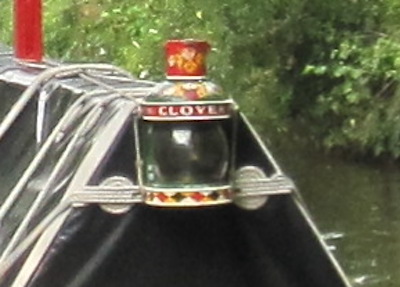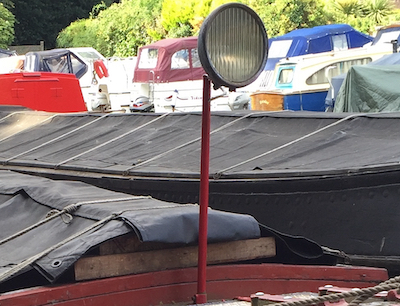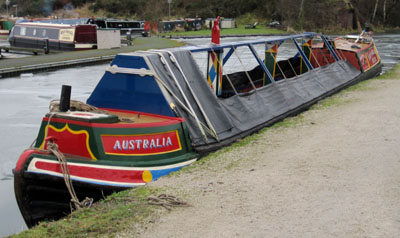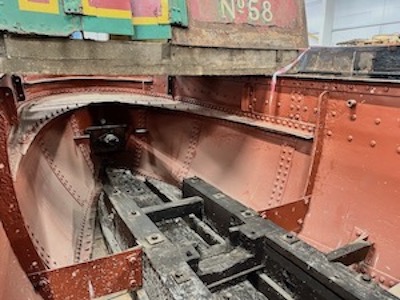< back to Know Your Boats
Introduction to Boat parts
One of the aims of HNBC is to promote and campaign for the retention and/or reinstatement of appropriate traditional and historical waterway furniture, features and working practices and the words associated with the boats matter and are worth recording. Of course, language changes and evolves, and modern leisure boats may well introduce new terms, but for the boats listed on this website the usual names for various parts are explained here, together with a note of terms that are sometimes mis-applied.
The first part covers what can easily be seen above the water line, starting at the fore end and working towards the stern, the second shows what is usually hidden below the surface.
All photographs in this section are by R Prettyman, HNBC Web Content Editor, unless otherwise attributed.
1. THE PARTS ABOVE THE WATER LINE
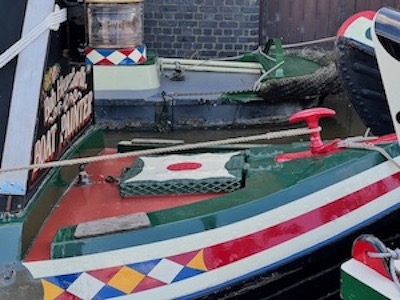 |
Deck |
The deck at the fore end of a narrow boat Note the ash strip which has some non-slip properties, as well as protecting the paintwork of the cants when stepping on. Many boaters kept them scrubbed white At the stern of a horse boat or a butty, a popular boater's addition was to put a flap of canvas over the cants, resting on the stern top bends between the anser pins. This canvas flap provided somewhere to step onto, except that some canvas flaps were painted with roses/landscapes/diamonds |
||
 |
Stempost |
The prow of a narrow boat [Photo: Kathryn Dodington] |
||
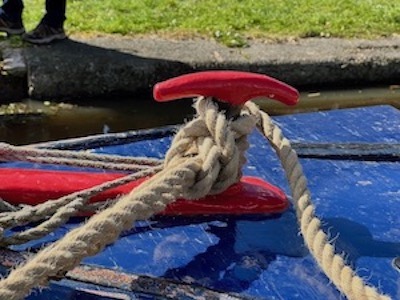 |
T-stud |
Found on the deck of most motors and butties - and also at the stern of butties |
||
 |
Cants |
Seen here (bright green) on the deck with a gap to allow for drainage. There are also stern cants on motors (see Counter below), butties and horse boats |
||
|
|
Headlight |
Can be beautifully painted Not used: 'tunnel lamp' |
||
|
|
Headlight | Can be a plainer headlamp from vintage cars/tractors | ||
 |
Deck lid |
Gives access to the storage area beneath the deck |
||
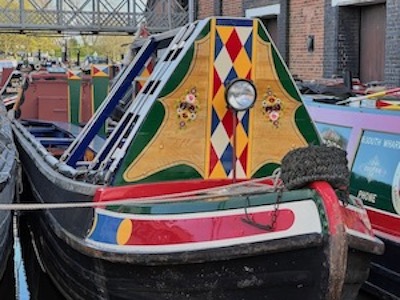 |
Deck board |
Triangular wooden board, supports the top plank and minimises water pouring in from leaky uphill lock gates Not used: 'cratch board' |
||
 |
Cratch False cratch |
The fore part of a narrow boat's hold, in horse boating days it was where the horse's fodder (hay and oats) was kept dry The false cratch is an A-shaped wooden framework forming the rearward part of the cratch |
||
 |
Fore cabin Guards
|
Provides extra living accommodation Bands of metal sitting proud of the hull to protect it, they are more numerous at the fore end and towards the stern |
||
|
|
Top planks |
Sturdy wooden boards running the length of the hold, they can be laid on the cross beams or raised up onto the stands to provide a framework for top cloths (tarpaulins) to cover the cargo In the 'up' position, uprights provide addtional support and side cloths strings are tied over them |
||
|
|
In this photo, the top planks are laid on the cross beams |
|||
 |
Box mast Towing mast |
Box shaped, wooden towing mast socketed into the keelson/kelson and secured on the mast beam. Inside the box is the towing mast, which can be raised or lowered |
||
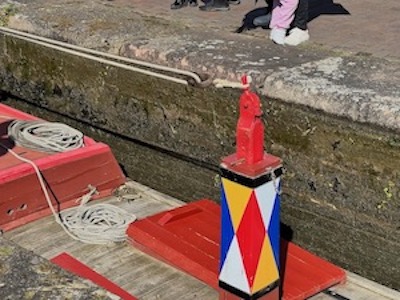 |
Looby/luby |
A swivelling piece of iron at the top of the towing mast, sprung to return to a vertical position From horse boating days, it is sprung such that the line slips off the looby if a boat overtakes its horse, so the horse is not dragged into the cut
|
||
 |
Stands |
Two vertical supports for the top planks in their highest rigged position, they fit through slots in two of the cross beams and locate in the keelson or in the false floor. Similar height as the box mast
|
||
|
|
Upright
|
Pieces of wood fixed between the gunnels and the top planks to provide extra support between the stands |
||
|
|
In this photo, the uprights and the box mast have been decorated with diamond patterns |
|||
|
|
Gunwale/ Gunnel |
The upper edge or planking of the side of a boat, most often used when referring to the narrow walkway along the cabin or the narrow strip along the top of the hold's sides [Photo: Vivienne Barber] |
||
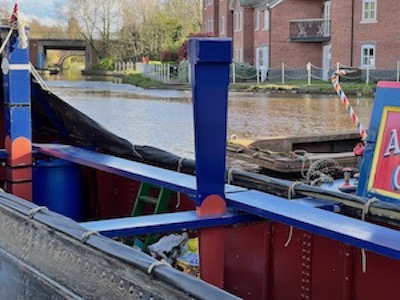 |
Cross beam |
Laid across the width of the hold to brace the hold sides in position, they also support the stands on which the top planks are placed In this photo, the top planks have been moved down to lie on the cross beams |
||
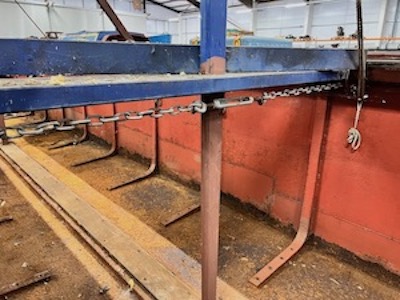 |
Chains |
Without chains to hold them in, the sides of a working narrow boat could splay out and cause the hold to spread, making passage through narrow locks difficult. The chains are tensioned by means of a central bottle screw |
||
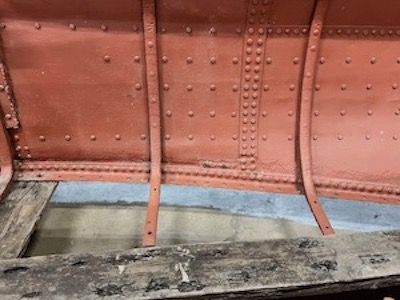 |
Knees |
The ribs along the length of the hold, fastened to the hull sides and to the bottom |
||
 |
Shutts |
False floors in the hold, used to keep cargo away from the actual bottom of a boat and to allow bilge and rainwater to accumulate below without affecting the cargo |
||
 |
Back end rail Back end line Back end boards
|
A metal rail, usually with a ring on it, at the front of the cabin/engine 'ole. Often has a back end line attached to quickly tie up the boat when stopping temporarily, or to provide a spring to stop the boat moving unduly when tied up Back end boards are laid across the width of the hold. Non-crew members must always use these to cross from one side of the boat to the other, it is considered extremely impolite to step onto or across a boat's counter without permission [Photo: Vivienne Barber] Not used: 'welly rail' |
||
 |
Engine 'ole |
Houses the engine, usually has side doors from both gunnels and sometimes an access door from within the cabin. Pictured, left, is an engine 'ole with its cabin top removed [Photo: Nick Wolfe] Not used (for the side doors): 'swan hatch'or 'duck hatch' |
||
 |
Pigeon box |
Usually positioned above the engine 'ole to provide ventilation and light |
||
 |
Cabin
Cabin top |
Living accommodation, next to the engine 'ole. This is the boater's home, it is considered extremely impolite to step onto the counter or to peer into the cabin either through the doors or the porthole. Non-crew members are expected to cross the boat by means of the back end boards The cabin top is the area over the cabin and the engine 'ole Not used: 'boatman's cabin', 'back cabin, 'the roof' |
||
|
|
Slide |
Sliding cover for the doors to the engine 'ole and the cabin living accommodation, often painted with a red symbol eg a heart, a circle, a club, a lozenge [Photo: Vivienne Barber] |
||
 |
Hatches |
The well deck of a butty or horse boat The term is often also used for the steering position on a motor - the steerer stands on the footboard in the door 'ole to benefit from the rising heat from the cabin range, as well as being safe from accidental and dangerous knocks from the tiller arm should the rudder become fouled on an underwater obstruction |
||
 |
Dolly |
A metal stump on a motor’s counter used for towing or tying up | ||
|
|
Anser/Answer pin |
Fitted at gunnel level towards the stern, anser pins with their accompanying hooks and shackles are used to tie two boats together side-by-side, called 'breasting up' This photo shows the anser pin on a horse boat |
||
|
|
This photo shows the hook fitted to the butty's anser pin |
|||
|
|
This photo shows the anser pin on a motor boat |
|||
 |
Counter |
Pictured, left, is the stern of a 1935 Woolwich Star Class motor. Many historic narrow boats no longer have wooden decks, originally constructed of oak, due to the time and cost of maintenance. The photo shows new ash strips nailed to the cants and breastwood The lower, thicker planks (about 2" thick) run fore-aft and the top layer, the shearing (about 1/2" thick) is laid athwartships and nailed into the lower planks. The shearing goes right to the after end The breastwood is secured next, on top of the shearing: it has holes for the rudder tube and the dollies
The dollies are fastened through the breastwood, the shearing and the lower plank layer
A wooden circular tapered washer is fastened onto the breastwood with its top about level with the top of the rudder tube. The top rudder bearing (a simple casting) fits into the top of the tube, to hold the rudder post in the centre of the inclined tube
Large staples are hammered into the breastwood, for fastening the stern fenders
Note the top guard is nailed into the edge of the cants and breastwood. The other
two guards are riveted to the hull
[Photo and text: Eric McDowall]
|
||
 |
Counter bands Guards |
The painted areas on the counter of motors, the top one usually a light colour for extra visibility at night, in tunnels or in gloomy conditions. The counter bands are separated by guards of which there are mostly three, but some boat yards applied four (as in the photo, left) Not used: 'tunnel bands' |
||
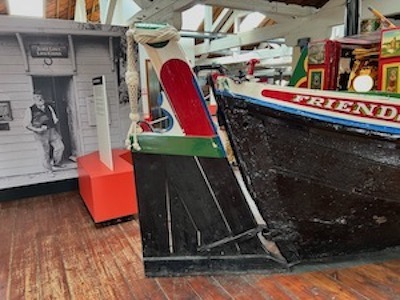 |
Ellum |
The steering mechanism of a narrow boat - rudder and tiller arm |
||
 |
Ram's head Swan's neck |
Z-shaped metal bar fitted to the top of a motor boat's rudder. Often now referred to as a Swan's Neck, although this term was originally for the ropework on a butty's ram's head (see photo below) A removable tiller bar is fitted to it and secured with a tiller pin |
||
 |
Ram's head |
The top of a butty's rudder into which the tiller arm fits The paintwork is protected by decorative ropework which itself is kept clean by scrubbing with plain cold water, detergents can cause it to dry with a brownish tinge [Information supplied by Beryl McDowall] |
2. THE UNDERWATER BITS
|
|
Swim |
The underwater taper (double curvature) from a boat's straight sides towards its stern This photo shows the external view of the stern swim on an FMC motor. The fine lines of working narrow boats mean that, despite their size, they swim well and are fast and manoeuvrable
|
||
|
|
Swim (internal view) |
|||
|
|
Swim |
This photo shows the underwater swim at the fore end, typical of boats built for efficient long distance work | ||
 |
Chines
|
Where the sides meet the bottom, usually at quite a sharp angle Some boats have rounded chines, particularly middle Northwiches, which tends to make them roll but, it is claimed, they slip off the mud more easily too Some middle Northwiches were converted to tugs or ice boats by canal companies eg Sickle
|
||
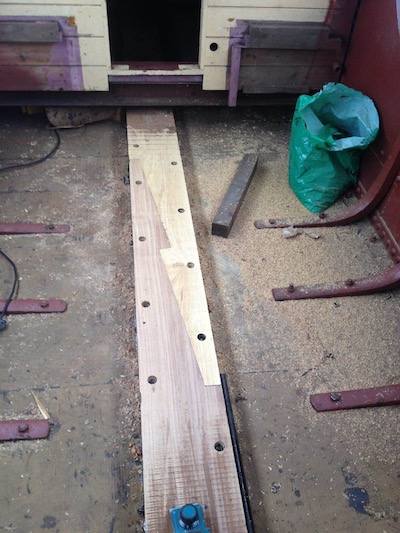 |
Keelson/kelson |
Part of a boat's bottom, it runs fore-and-aft along the centre line. [Photo: Simon Wain] Not used: 'keel' |
||
 |
Composite |
Many boats were built with iron/steel sides with wooden bottom boards, and are known as iron-composite or steel-composite |
||
 |
Blades/fan |
The propeller |
||
 |
Skeg Rudder |
Pictured is the rudder and skeg of a 1935 Woolwich Star Class motor boat The skeg is a part of the cast (or forged) stern post. The rudder post sits in the 'cup' at the very stern end of the skeg
The rudder is fabricated from steel plate and riveted together. A nicely shaped cast piece stiffens the bottom edge
The rudder post is inclined at about 5 degrees off-vertical, with the top of the post (at the deck) being further aft than the cup. This makes the rudder 'self centre', when the tiller is let go
The part, painted red, at the top stops the rudder from being able to turn so far round that it would otherwise get under the counter (and hit the propeller)
The small area of rudder plate ahead of the post is called the balance and effectively reduces the amount of effort required to push round the tiller. The bigger the balance area - the lighter the rudder feels
[Photo and text: Eric McDowall]
|

